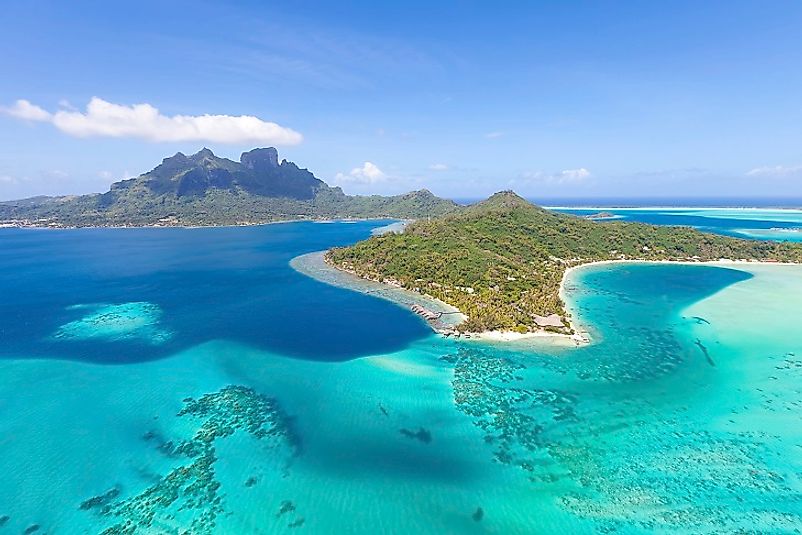Where Is The Island Of Tahiti?

5. Description
The largest of the Windward Islands of French Polynesia covers an area of 400 square miles. Tahiti is enveloped by coral reefs and divided into two parts. These are the larger Tahiti Nui in the northwestern part, and the much smaller Tahiti Iti in the southeastern part of the island. Tahiti Nui and Tahiti Iti are connected by a very narrow strip of land. Tahiti and its montane topography were the result of the kind of underwater volcanic activity that also marks many of the South Pacific islands. Papa'ete is the capital city of French Polynesia, but Tahiti acts as the center of politics, culture, and economy of the country. As the country's name suggests, Polynesian people dominate the islands, with most of the rest being of European or Chinese origins.
4. Historical Role
Tahiti was first settled by Indonesians who sailed from Southeast Asia through Fiji, Samoa, and the Tonga Islands. They sailed on 65 to 100 foot-long outrigger canoes with their families and livestock on board. Upon settling the islands, the people organized their societies into clans and chiefdoms. A Chief headed each clan, but a council of elders was given the final say. Two of the first Europeans to reach the islands were Portuguese navigator Pedro Queiros, in 1606, and Spanish explorer Juan Fernandez in 1576. British Royal Navy Captain James Cook came and collected flora and fauna in the 18th Century, while Peruvian Viceroy Manuel de Amat claimed the islands for Spain around the same time in 1772. The British dropped anchor in 1788 with a botanical mission. The whalers arrived in 1790, bringing European diseases to the natives in the process. In 1797, British missionaries arrived as well to introduce Christianity to the islanders.
3. Modern Significance
Tourism contributes a great deal to the country's economy. Black pearls, vanilla, fruits, flowers, fish, copra, noni juice, and monoi fragrance oil make up the lion's share of export earnings from the country. French investments and imports-export traffic with Japan, New Zealand, Australia, and the US also add to the bulk of the country's earnings. Local arts and crafts are part of the tourist trade as well, while surfing and rugby are two of the country's most popular sports. The otea is the national dance in Tahiti, similar to Hawaii's hula dance. The College La Mennais in Papeete, and the University of French Polynesia in Tahiti, are the schools of choice for higher education in the islands. Papeete, the capital of the country, has an international airport with five airlines serving it. Three ferry companies also serve the islands.
2. Habitat and Biodiversity
There are ten mountain peaks in Tahiti that rise above 5,000 feet in elevation, and three that reach 6,662 feet or more in height. Mount Orohea, which reaches 7,352 feet in height, is the highest peak on the island. Habitats on Tahiti include montane and rain cloud forests, as well as sub-alpine forests. The cloud forest has shrubs, trees, ferns, orchids, and mosses. The sub-alpine forest contains small shrubs that are the main features of most sub-alpine biomes. The lower habitats consist of coastal plains, inlets, and ridges. The volcanic topography shaped much of the island's geomorphology as well. There are 31 bird species that call the island their home. The months of October through May are the dry months, while November through April represents the wet season.
1. Environmental Threats and Territorial Disputes
Human-introduced plants and animals have influenced the biodiversity in the lowlands, but have not extensively affected the sub-alpine and cloud forests. The early Polynesians unknowingly contributed to the threats by bringing with them around 30 introduced food plants, which included bamboo and coconut. One vascular plant that has threatened the native species is the Miconia Calvescens. It has invaded around two-thirds of the island, threatening the brooding ground and food sources of many native birds. The Tutururu, a very endangered bird whose population is now down to 150 birds, as well as the Storm petrel and sandpiper, are being revived with habitat protection efforts. Local citizens, the Tahitian government, and non-governmental agencies alike all are working towards restoring the balance of the ecological systems so that many of the endangered species may be saved.











